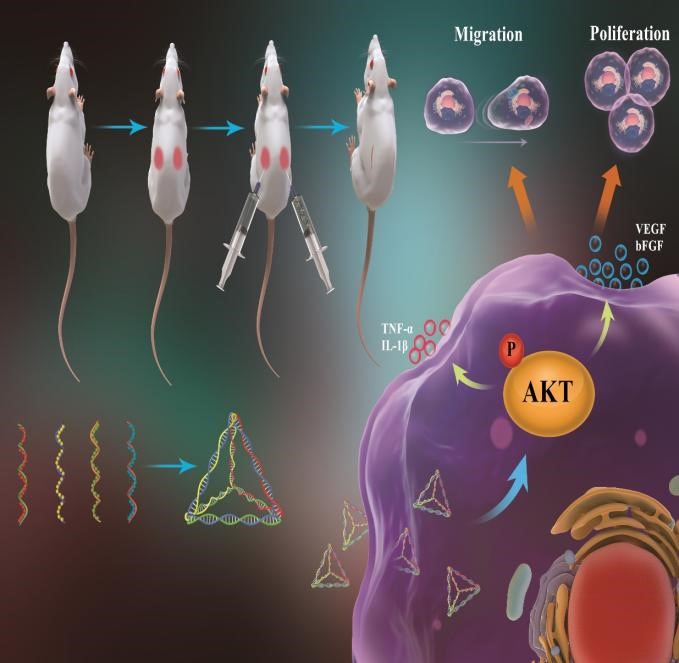Tetrahedral Framework Nucleic Acid Technology in skin anti-aging
2024-06-28
The state of youthful
skin is closely related to the vitality of skin cells and the composition of
the extracellular matrix (ECM). Skin aging can be categorized into intrinsic
aging, caused by internal factors, and extrinsic aging, which is secondary to
external factors such as environmental stressors like UV radiation, pollution,
exhaust gases, and life stress, with UV radiation being the most significant
factor. When the skin is exposed to UV radiation, excessive reactive oxygen
species are generated within cells, leading to the expression of aging-related
genes, triggering inflammatory cascades, and reducing the levels of elastin and
collagen, resulting in skin sagging, wrinkles, and other signs of photoaging.
Photoaging primarily occurs in the dermis. Enhancing the content of elastin and
key collagen types in the dermis can effectively mitigate skin damage caused by
environmental stimuli and slow down the skin aging process.
The ECM is a crucial
component in maintaining skin structure and function, with collagen being one
of its key proteins. Among these, type I and type III collagens and elastin are
particularly important. In youthful skin, the total content and ratio of type I
and type III collagens play a significant role in maintaining skin elasticity
and firmness. Although elastin makes up only 2% of the total protein in the
dermis, it allows the skin to "quickly return" to its original shape
after stretching or contracting.

Anti-aging Effects of Tetrahedral Framework Nucleic Acids on the Skin
Tetrahedral Framework Nucleic Acids (tFNA) have anti-aging effects on the skin through their anti-inflammatory and antioxidant functions, which are crucial for skin rejuvenation:
AKT Pathway Promotion for Damage Repair: tFNA can enhance scarless wound healing by activating the AKT signaling pathway. Inflammatory responses and scar formation during wound healing are significant factors in skin aging. tFNA helps reduce scar formation by decreasing inflammation factor production and promoting cell proliferation, thus contributing to skin anti-aging.
Activation of Wnt Signaling Pathway: By activating the Wnt signaling pathway, tFNA promotes wound healing in diabetic conditions. The Wnt pathway plays a key role in regulating cell proliferation, differentiation, and tissue regeneration, which may also aid in skin anti-aging.
Anti-Inflammatory Effects: tFNA reduces the release of inflammatory cytokines (such as NO, IL-1β, IL-6, and TNF-α) and exerts anti-inflammatory effects by inhibiting the expression of iNOS genes and proteins. Since inflammation is a significant factor in skin aging, reducing inflammatory responses helps delay the aging process.
Antioxidant Effects: tFNA promotes cellular antioxidant activities by inhibiting the phosphorylation of proteins ERK1/2, P38, and JNK in the MAPK/ERK signaling pathway, and by enhancing the expression of heme oxygenase-1 (HO-1). Oxidative stress is another critical factor in skin aging, and tFNA’s antioxidant effects protect skin cells from damage caused by free radicals.
Bioavailability and Biocompatibility: tFNA exhibit good bioavailability and biocompatibility, meaning they can safely penetrate skin cells and remain active within the cytoplasm, which is crucial for drug delivery and therapeutic applications.
Anti-Aging Effects: Experiments have demonstrated that tFNA significantly reduce the expression of inflammatory factors and the production of reactive oxygen species (ROS) in LPS-stimulated RAW264.7 cell models, thereby exhibiting anti-aging effects.
Potential Skin Applications: Due to these properties, tFNA have the potential to be developed into new anti-aging treatments for the skin, which could be used topically or in combination with other anti-aging ingredients to enhance skin health and delay aging.
Safety and Stability: The stability of tFNA within cells is essential for their safety and effectiveness as long-term anti-aging agents.
Regulation of Extracellular Matrix (ECM): tFNA may affect skin elasticity and firmness by modulating ECM components such as collagen and elastin. Changes in these ECM components are closely related to the aging process of the skin.
Enhanced Fibroblast Repair and ECM Component Expression: tFNA promote fibroblast repair and increase the expression of ECM components (Collagen I, Collagen III, and Elastin) after UV damage. Human fibroblasts exposed to a total dose of 9 J/cm² UVA radiation showed significant increases in Collagen I, Collagen III, and Elastin content at concentrations of 2.5 ppm, 5 ppm, and 10 ppm, with statistical significance compared to the negative control group (p<0.05).
Core Advantages of the Approach
1. New Anti-Aging Material: This approach offers a novel skin anti-aging material with an exceptionally low effective concentration, significantly reducing usage costs. Additionally, increasing the concentration can yield better results, demonstrating that tetrahedral nucleic acids (tFNA) have a high potential for anti-aging efficacy.
2. Safety and Biocompatibility: Tetrahedral nucleic acids are artificially designed nanostructures with excellent biocompatibility. Unlike protein-based anti-aging materials, tFNA have no immunogenicity and do not pose a risk of skin allergies. Overall, tFNA offer a high level of safety as a new anti-aging material.
In summary, tFNA exert anti-aging effects on the skin through various mechanisms, including promoting wound healing, anti-inflammatory and antioxidant actions, regulating cell proliferation and migration, and potentially affecting ECM components and activating critical cell signaling pathways. These characteristics make tFNA a promising anti-aging treatment, contributing to skin health maintenance and the delay of the aging process.



